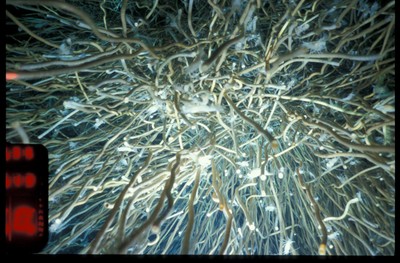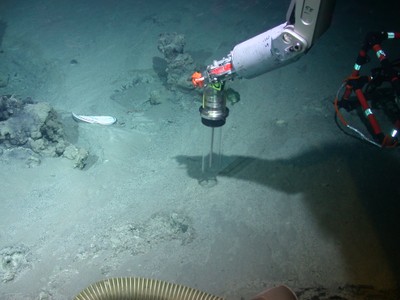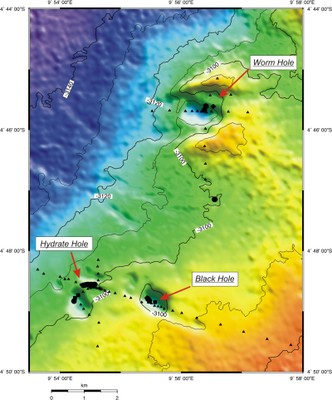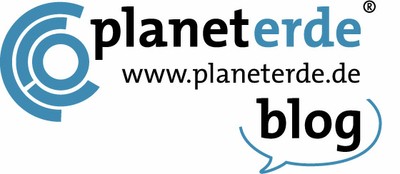Page path:
- Press Office
- Press releases 2008
- 11.07.2008 Linking deep sea biodiversity and cl...
11.07.2008 Linking deep sea biodiversity and climate dynamics
Blog Nr. 1: 17 July 2008 Leaving Walvis Baai
(by Christina Bienhold)
Blog Nr. 2: 18 July 2008: " Welcome to ROV Town"
(by Christina Bienhold)
Blog Nr. 2: 18 July 2008: " Welcome to ROV Town"
Read all blogs on www.planeterde.de
International scientists report from current METEOR-Expedition on the geoportal planeterde.de
Which organisms inhabit the dark and cold deep-sea ocean? How do they affect our climate on planet Earth? How is life and work on a research vessel? All these and other questions will be answered by the Bremen cruise leader Prof. Dr. Antje Boetius and the international scientific crew on board METEOR. In cooperation with the Max-Planck-Institute for Marine Microbiology (MPI-MM) the expedition participants will contribute an online science-blog of the 76th Meteor cruise at the Geoportal planeterde.de. Expedition M 76/3b is a collaboration of the MARUM – Zentrum für Marine Umweltwissenschaften at the University of Bremen and its partner institutes MPI, AWI and the French research institute IFREMER and the University of Paris. The remote-controlled vehicle QUEST4000 of MARUM will be used for deep-sea dives off the West African coast. Focus of its high-resolution cameras: The bizarre fauna of gas and fluid seeps located at the deep West African continental margin. Of major scientific interest is the connection between geophysical and geochemical processes and the biodiversity of the rich life at the African seeps, as well as the effect of the seep community on climate relevant gases.
QUEST is a remote controlled underwater robot. ( MARUM, Universität Bremen)
Life on methane
The deep ocean is sometimes teeming with strange organisms: white crabs roam the ocean floor, huge tube worms sway with the water flow and giant mussel fields form around bubbling gas vents. In the deep sea, some life depends on other energy sources than algal detritus such as hydrogen, sulfide or methane gas and other hydrocarbons. These energy-rich substances can form due to bacterial degradation of organic matter, or by thermogenic processes due to the increasing heat in deeper sediment layers. Over long time periods, the products of such processes such as methane gas can accumulate and form large reservoirs. If sediment instabilities or other events lead to leakage or eruption of such reservoirs huge sediment masses, fluids and gases can be transported to the ocean floor. A result of such catastrophic events are small (1-2 m) to giant (1-2 km) holes in the ground – the so called pockmarks. If gases and fluids continue to escape from the seafloor “cold seeps” ecosystems form, where methane and sulfide represent the major energy sources for abundant microbial life and chemosynthetic animals that fix CO2 with the help of their symbionts.
The deep ocean is sometimes teeming with strange organisms: white crabs roam the ocean floor, huge tube worms sway with the water flow and giant mussel fields form around bubbling gas vents. In the deep sea, some life depends on other energy sources than algal detritus such as hydrogen, sulfide or methane gas and other hydrocarbons. These energy-rich substances can form due to bacterial degradation of organic matter, or by thermogenic processes due to the increasing heat in deeper sediment layers. Over long time periods, the products of such processes such as methane gas can accumulate and form large reservoirs. If sediment instabilities or other events lead to leakage or eruption of such reservoirs huge sediment masses, fluids and gases can be transported to the ocean floor. A result of such catastrophic events are small (1-2 m) to giant (1-2 km) holes in the ground – the so called pockmarks. If gases and fluids continue to escape from the seafloor “cold seeps” ecosystems form, where methane and sulfide represent the major energy sources for abundant microbial life and chemosynthetic animals that fix CO2 with the help of their symbionts.
Bizarre life in the deep sea. H. Sahling, MARUM
Deep-Sea habitats and methane
„Major topic of the cruise will be the link between methane emission, gas hydrates and the distribution and diversity of organisms at methane seeps”, explains Prof. Dr. Antje Boetius, chief scientist of METEOR cruise M76/3b and head of the Microbial Habitat Group at the Max-Planck-Institute for Marine Microbiology in Bremen. How biodiversity might be coupled to geological and biogeochemical processes of gas and fluid seeps is a central question of the international science team. The research target is the deep West African continental margin. Here, French oceanographers discovered hot spots of biodiversity six years ago associated with giant pockmarks. The deep African pockmarks are characterized by huge biomasses of seep organisms, abundant gas venting, surficial gas hydrates and a high diversity of microhabitats. “We want to investigate the role of the seep ecosystems in controlling methane efflux, and why biodiversity and biomass of deep-sea life is particularly high at these places.” continues Antje Boetius. “Geochemical, geological as well as biological questions about these seep ecosystems and their inhabitants, from microorganisms to mega fauna, will determine our work plan.”
„Major topic of the cruise will be the link between methane emission, gas hydrates and the distribution and diversity of organisms at methane seeps”, explains Prof. Dr. Antje Boetius, chief scientist of METEOR cruise M76/3b and head of the Microbial Habitat Group at the Max-Planck-Institute for Marine Microbiology in Bremen. How biodiversity might be coupled to geological and biogeochemical processes of gas and fluid seeps is a central question of the international science team. The research target is the deep West African continental margin. Here, French oceanographers discovered hot spots of biodiversity six years ago associated with giant pockmarks. The deep African pockmarks are characterized by huge biomasses of seep organisms, abundant gas venting, surficial gas hydrates and a high diversity of microhabitats. “We want to investigate the role of the seep ecosystems in controlling methane efflux, and why biodiversity and biomass of deep-sea life is particularly high at these places.” continues Antje Boetius. “Geochemical, geological as well as biological questions about these seep ecosystems and their inhabitants, from microorganisms to mega fauna, will determine our work plan.”
Taking samples with QUEST (MARUM).
High technology supports multidisciplinary ecosystem research
TV-guided instruments will be primarily in use during the cruise, foremost the remotely-controlled deep-sea robot QUEST of MARUM. With the development of such robots that deliver realistic pictures of the deep ocean and allow visually targeted sampling of small structures and organisms, marine science moved a big step forward. “The process of learning is substantially accelerated.”, tells cruise leader and biologist Antje Boetius, “While taking samples and conducting measurements one can observe the surrounding environment and make important discoveries about the deep sea.” A high working load is planned for the all-rounder QUEST: To carry out experiments at the seafloor the diving robot will place autonomous benthic chambers and microbial incubators. Detailed knowledge of the distribution and diversity of the marine fauna will be obtained by sampling fluids, sediments and organisms, by collecting video and photographic material and by biological activity measurements such as sulphur, methane, and oxygen consumption in different seep habitats.
TV-guided instruments will be primarily in use during the cruise, foremost the remotely-controlled deep-sea robot QUEST of MARUM. With the development of such robots that deliver realistic pictures of the deep ocean and allow visually targeted sampling of small structures and organisms, marine science moved a big step forward. “The process of learning is substantially accelerated.”, tells cruise leader and biologist Antje Boetius, “While taking samples and conducting measurements one can observe the surrounding environment and make important discoveries about the deep sea.” A high working load is planned for the all-rounder QUEST: To carry out experiments at the seafloor the diving robot will place autonomous benthic chambers and microbial incubators. Detailed knowledge of the distribution and diversity of the marine fauna will be obtained by sampling fluids, sediments and organisms, by collecting video and photographic material and by biological activity measurements such as sulphur, methane, and oxygen consumption in different seep habitats.
The region of interest is the Congo basin. (V. Spiess, MARUM)
Other relevant research sites (MARUM).
Long-term study via „Eco-Module“
Temporal variation of chemosynthetic communities will be assessed by the deployment of moorings with ecological observation modules that will stay at the REGAB pockmark for six months. Until its recovery by French colleagues from the marine research institute Ifremer (Project DEEPOASES) in 2009, the module will analyze the variation of the communities at seep ecosystems and document their development with video clips.
Temporal variation of chemosynthetic communities will be assessed by the deployment of moorings with ecological observation modules that will stay at the REGAB pockmark for six months. Until its recovery by French colleagues from the marine research institute Ifremer (Project DEEPOASES) in 2009, the module will analyze the variation of the communities at seep ecosystems and document their development with video clips.
Contact
Contact for pictures and interviews:
Dr. Manfred Schlösser
Public relations at MPI for Marine Microbiology Bremen
Tel.: 0421 2028 - 704
E-Mail: [Bitte aktivieren Sie Javascript]
Albert Gerdes
Public relations at MARUM - Center for Marine Environmental Sciences
Tel.: 0421 218 - 65540
E-Mail: [Bitte aktivieren Sie Javascript]
Information of scientific background:
Prof. Dr. Antje Boetius
Tel.: 0421 2028 - 860
E-mail: [Bitte aktivieren Sie Javascript], now [Bitte aktivieren Sie Javascript]
Contact geoportal planeterde.de:
Dr. Astrid Ahke
Marine Environmental Scientist and Public Relations Assistant
Editorial office www.planeterde.de
Tel.: 0228 55525 - 33
E-Mail: [Bitte aktivieren Sie Javascript]
METEOR-Blog
Information of the participating research institutes:
Max-Planck-Institute for Marine Microbiology
Celsiusstrasse 1
28359 Bremen
www.mpi-bremen.de
MARUM - Center for Marine Environmental Sciences
der Universität Bremen
Leobener Str.
28359 Bremen
www.marum.de
FB 05 - Department 05: Geosciences
Postfach 330440
28334 Bremen
www.geo.uni-bremen.de
Universiteit Gent
Vakgroup Biologie
Krijgslaan 281 S8
9000 Gent
http://wetenschappen.ugent.be/site/index_eng.html
CNRS
Centre national de la recherche scientifique
Siège: 3, rue Michel-Ange
75794 PARIS cedex 16/ France
http://www.locean-ipsl.upmc.fr
Adaptation et Evolution en milieux extrêmes
Directrice adjointe de l’UMR 7138 CNRS IRD MNHN UPMC
Systematique Adaption Ecvolution
Université Pierre et Marie Curie
Bat A 4 etage, case 5
7 Quai Saint Bernard 75005 Paris France
http://amex.snv.jussieu.fr
The MARUM aims at unraveling the role of the oceans in the Earth system by employing state-of-the-art methods. It examines the significance of the oceans in the framework of global change, quantifies interactions between the marine geosphere and biosphere, and provides information for a sustainable use of the ocean.
A member of the Max-Planck-Society, the Max-Planck-Institute for Marine Microbiology is a public institute for scientific marine research. More than 200 scientists of over 20 different nationalities are working in three departments Biogeochemistry, Microbiology and Molecular Ecology at the Bremen institute. Their research investigates the role, diversity and characteristics of marine microorganisms.
National institute of marine research, the French public institute for marine research, IFREMER contributes, through studies and expert assessments, to knowledge about the ocean and its resources, monitoring of marine and coastal zones and the sustainable development of maritime activities. To these ends, it designs and operates observational, experimental and monitoring tools and facilities. IFREMER manages the ocean research fleet for the French scientific community.
Dr. Manfred Schlösser
Public relations at MPI for Marine Microbiology Bremen
Tel.: 0421 2028 - 704
E-Mail: [Bitte aktivieren Sie Javascript]
Albert Gerdes
Public relations at MARUM - Center for Marine Environmental Sciences
Tel.: 0421 218 - 65540
E-Mail: [Bitte aktivieren Sie Javascript]
Information of scientific background:
Prof. Dr. Antje Boetius
Tel.: 0421 2028 - 860
E-mail: [Bitte aktivieren Sie Javascript], now [Bitte aktivieren Sie Javascript]
Contact geoportal planeterde.de:
Dr. Astrid Ahke
Marine Environmental Scientist and Public Relations Assistant
Editorial office www.planeterde.de
Tel.: 0228 55525 - 33
E-Mail: [Bitte aktivieren Sie Javascript]
METEOR-Blog
Information of the participating research institutes:
Max-Planck-Institute for Marine Microbiology
Celsiusstrasse 1
28359 Bremen
www.mpi-bremen.de
MARUM - Center for Marine Environmental Sciences
der Universität Bremen
Leobener Str.
28359 Bremen
www.marum.de
FB 05 - Department 05: Geosciences
Postfach 330440
28334 Bremen
www.geo.uni-bremen.de
Universiteit Gent
Vakgroup Biologie
Krijgslaan 281 S8
9000 Gent
http://wetenschappen.ugent.be/site/index_eng.html
CNRS
Centre national de la recherche scientifique
Siège: 3, rue Michel-Ange
75794 PARIS cedex 16/ France
http://www.locean-ipsl.upmc.fr
Adaptation et Evolution en milieux extrêmes
Directrice adjointe de l’UMR 7138 CNRS IRD MNHN UPMC
Systematique Adaption Ecvolution
Université Pierre et Marie Curie
Bat A 4 etage, case 5
7 Quai Saint Bernard 75005 Paris France
http://amex.snv.jussieu.fr
The MARUM aims at unraveling the role of the oceans in the Earth system by employing state-of-the-art methods. It examines the significance of the oceans in the framework of global change, quantifies interactions between the marine geosphere and biosphere, and provides information for a sustainable use of the ocean.
A member of the Max-Planck-Society, the Max-Planck-Institute for Marine Microbiology is a public institute for scientific marine research. More than 200 scientists of over 20 different nationalities are working in three departments Biogeochemistry, Microbiology and Molecular Ecology at the Bremen institute. Their research investigates the role, diversity and characteristics of marine microorganisms.
National institute of marine research, the French public institute for marine research, IFREMER contributes, through studies and expert assessments, to knowledge about the ocean and its resources, monitoring of marine and coastal zones and the sustainable development of maritime activities. To these ends, it designs and operates observational, experimental and monitoring tools and facilities. IFREMER manages the ocean research fleet for the French scientific community.
Planeterde.de blog
METEOR-Blog on planeterde.de continues
Bremen scientists report another time about their work, research and life on board of the German research vessel METEOR. At the beginning of the 76th METEOR expedition coordinated by the MARUM, the readers of the geoportal planeterde.de were able to dive to the deep biosphere of the Namibian seafloor. Now, primarily young scientists from six nations join the last leg of the research journey to the African margin. Together with cruise leader Antje Boetius, the scientists from the Max Planck Institute for Marine Microbiology Bremen, the Department of Geosciences of the Alfred Wegener Institute,the MARUM-Zentrum für Marine Umweltwissenschaften at the University of Bremen, the Ifremer in Brest, and the University of Paris.
Bremen scientists report another time about their work, research and life on board of the German research vessel METEOR. At the beginning of the 76th METEOR expedition coordinated by the MARUM, the readers of the geoportal planeterde.de were able to dive to the deep biosphere of the Namibian seafloor. Now, primarily young scientists from six nations join the last leg of the research journey to the African margin. Together with cruise leader Antje Boetius, the scientists from the Max Planck Institute for Marine Microbiology Bremen, the Department of Geosciences of the Alfred Wegener Institute,the MARUM-Zentrum für Marine Umweltwissenschaften at the University of Bremen, the Ifremer in Brest, and the University of Paris.






